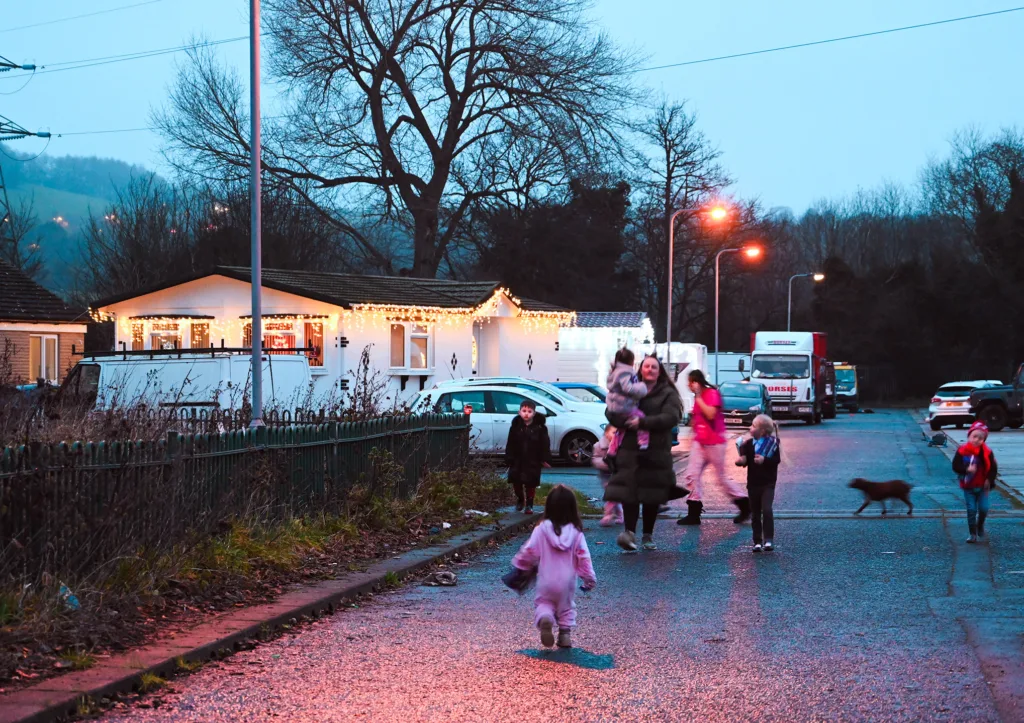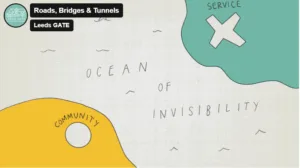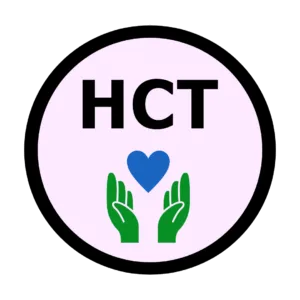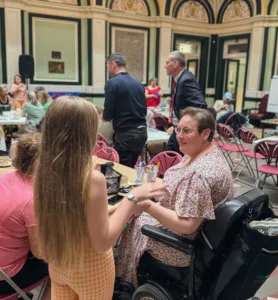
By Ellie Rogers, Leeds GATE CEO
Leeds GATE is a community members’ organisation and registered charity for Gypsies and Travellers in West Yorkshire. We deliver a wide range of community development, youth and advocacy work, led by and for our members. Our communities are strong, intelligent, resourceful and kind – yet they experience some of the most extreme health inequalities in the UK. Gypsies and Travellers die on average 12 years earlier than the general population and become frail much sooner.
Every day we see signs of a community under pressure: high suicide rates, domestic violence, poor mental health and preventable early deaths. These are not isolated tragedies but symptoms of institutional and environmental racism. Long-standing policies and practices have marginalised Gypsy and Traveller people, eroding social support systems and limiting access to housing, education and employment. Over-representation in the care and criminal justice systems only deepens this harm.
For two decades Leeds GATE has championed inclusion health and witnessed successive NHS reorganisations promising to put inequalities at the centre. As Core 20 PLUS 5 fades from view, how can the new Neighbourhood Health approach and the forthcoming NHS Ten-Year Health Plan work for our members?
This next phase of system change must remain accountable – not just in words but in outcomes – to the people whose health is most at risk. In the sharing of some of our own concepts and learning informed by community expertise, we aim for reflection and a call to action.
What Neighbourhood Health aims to do
The NHS Ten-Year Plan sets clear priorities that drive current reforms:
- Reducing pressure on emergency and hospital care by preventing illness earlier and supporting people to stay well at home.
- Embedding community voice and action in the design and delivery of services.
- Integrating health and care through neighbourhood multidisciplinary teams.
- Strengthening primary care to understand and serve its local populations.
- Building personal, relational care rather than transactional encounters – improving uptake of immunisations, screening and health checks while reducing avoidable admissions.
Neighbourhood Health is the framework to deliver these ambitions locally. It asks every Integrated Care System to join up services around real people and places, supported by shared data, digital access and local leadership. For Leeds GATE, the challenge is clear: how do we ensure this works for those on the margins, and that Gypsies and Travellers are not left behind once again?
Applying our learning – how our thinking has developed
We strongly support the vision of a more relational, community-centred NHS.
The logic is sound: personal care keeps people well; integrated teams save lives. But the test will be whether this new model flexes to meet the needs of the most excluded and those whose needs don’t fall neatly into a geographical neighbourhood.
For inclusion health groups, some hard questions remain:
- Will services be flexible enough to meet people where they are?
- How will those without digital devices or skills be supported to access care?
- Will primary care communication improve, with simpler language and accessible systems?
- Will data on Gypsy and Traveller health finally be collected, tracked and acted on?
- Will proportionate universalism guide decisions, recognising different levels of need?
- Will representation, stigma and discrimination be tackled as part of building trust?
Over many years of community health advocacy, Leeds GATE has developed several key concepts that speak directly to these challenges. They are examples of community voice and action embedded in healthcare – designed with and by marginalised people. You can read about some of these here.
-
Designing from the Margins
First championed by our founder Helen Jones, this idea argues that systems should be designed from the experiences of those most affected by inequality. If we build services that work for the most excluded, they will work better for everyone.
The Neighbourhood Health ambition already echoes this thinking. The daily scramble for GP appointments doesn’t work for anyone, but it is especially impossible for people juggling trauma, caring responsibilities or insecure accommodation. Compassionate, flexible, culturally aware care benefits all. By practising “design from the margins” we learn to build flexibility, empathy and clear communication into every interaction – not as an add-on, but as the norm.
-
From Outreach to Inreach
Our health advocacy work introduced the concept of Outreach to Inreach. Outreach meets people where they are, but true inclusion goes further: it changes systems so they can meet people properly next time.
For example, when an outreach nurse visits a Traveller encampment where families have been refused GP registration for lack of ID, she doesn’t stop at giving advice. She also visits the practice, explains the legal duties to register patients and provides guidance on Gypsy and Traveller health needs. In doing so, she brings inclusion into the system. Outreach opens the door; inreach keeps it open.
We often describe specialist “bridging” services as essential yet fragile. They connect excluded groups to mainstream care, but they can be the first to face cuts. Too often they become one-way referral routes – easy to send people into, harder to welcome them back from.
Our “Roads, Bridges and Tunnels” model challenges this. Roads represent universal services that everyone should access; bridges are temporary supports that help people cross into them; tunnels are the deeper system changes that make the roads wider and fairer. Sustainable inclusion means widening the road, not endlessly rebuilding the same bridge.
Learn more by watching our short video about the model and how health services can implement this approach with communities.

Healthy Communities Together (HCT) was a collaborative initiative running from 2021-2025, dedicated to transforming healthcare systems and reducing health inequalities for some of the most marginalised communities in Leeds; refugees and asylum seekers, Gypsies and Travellers, sex workers, and trans and non-binary communities. The project on a solidarity network of organisations that had worked together since 2016 that support these communities – Basis Yorkshire, Yorkshire MESMAC, LASSN and ourselves at Leeds GATE. By placing people with lived experience at the heart of service design and decision-making, HCT ensures that healthcare services are tailored to meet the real needs of these communities.
Learn more from our Healthy Communities Together project page and see our reports and insights.

Inclusion Health Virtual Neighbourhoods
To make Neighbourhood Health work for dispersed and mobile populations, we are developing the idea of Virtual Neighbourhoods – inspired by the Virtual School model used for Gypsy, Traveller and looked-after children.
A Virtual Neighbourhood provides governance for inclusion health groups across an Integrated Care System. It tracks outcomes, shares good practice and ensures accountability for populations often invisible in data. Its functions would include:
Data – Improving collection and monitoring progress
Listening – Using community intelligence to bridge data gaps, developing trusted relationships ensuring complaints processes can be accessed by those on the margins
Sharing good practice – sharing innovative ways primary care can work for marginalised people, helping practices to implement, having oversight of their strategies around this
Training and development – providing training and learning for practitioners to improve their practice with inclusion health cohorts
Commissioning – bridging services where needed
Leadership – being identified in a central place (ICB’s, Health and Wellbeing Boards) but also in local MDT’s to lead on collating evidence and driving forward progress in a hub and spoke approach
Troubleshooting – a place for communities to go when things are going wrong
For example – last year half of a local Traveller site who already have very unequal access to local GP practices got deregistered from a practice they had been with for many years. Where do communities go with such inequalities? A central lead for health inclusion creates a place to hold this. A Virtual Neighbourhood could have caught that earlier and offered a route to challenge it. Without data and oversight, such injustices go unnoticed.
Neighbourhood Health already recognises that health is shaped by housing, employment and poverty. But for communities like Gypsies and Travellers, these determinants are not abstract concepts – they are daily barriers to care. A social-prescribing service cannot fix poor housing if it has no leverage over housing policy.
To make “community voice and action” real, neighbourhood teams must use their strategic power to advocate for these wider building blocks of health: secure housing, decent income, affordable food and freedom from discrimination. Prevention and prediction mean little if we ignore the structural causes of illness. The evidence is clear: inequality is the biggest driver of poor health, and for inclusion health groups those inequalities are stark and deadly.
Without governance, the unique needs of inclusion health groups and the specific advocacy they need and deserve, will not happen. For example, our roadside families (who are often homeless), need strategic advocacy from the health sector to encourage compassionate approaches, prioritisation of health needs and longer stays. There won’t be the capacity, knowledge or focus to do that across multiple neighbourhood teams but a virtual neighbourhood could bring the technical knowledge, the passion and the resource to bear in framing this as an issue of health inequality.

Building a Model that Works
Voluntary and community organisations are already leaders in multi-disciplinary approaches and in bringing care closer to home. As we say to our members, we’ll help you with anything we’ve got the skills to and if you need specialist knowledge – we will ensure you can access that, handing it over with care, still holding threads and being that fall back if things go wrong.
Leeds GATE works hand-in-hand with communities, spotting issues early and helping professionals understand the context behind a patient’s life. Our approach is grounded in relationships, not transactions.
To make Neighbourhood Health succeed, statutory partners must recognise and resource this role. The voluntary sector offers trusted access, cultural knowledge and continuity that large systems cannot replicate. Partnership should mean shared power, not consultation after the fact.
For Gypsies and Travellers, this could mean real progress: care that is culturally competent, accessible, and confident in addressing inequality. For the NHS, it means a more effective and compassionate system that delivers its own promise of health for all.
Neighbourhood Health will only succeed if people on the margins are part of the design, the delivery and the accountability. Communities like ours are ready to help – we always have been. What we need now is partnership that listens, learns and acts.


